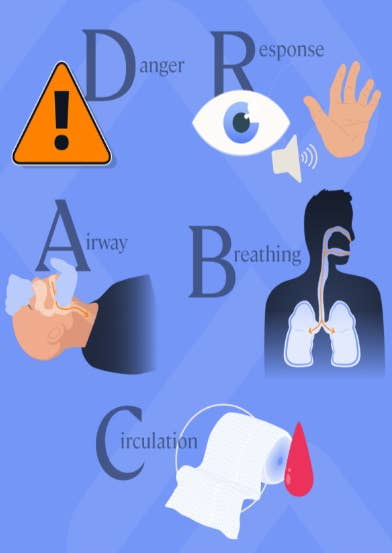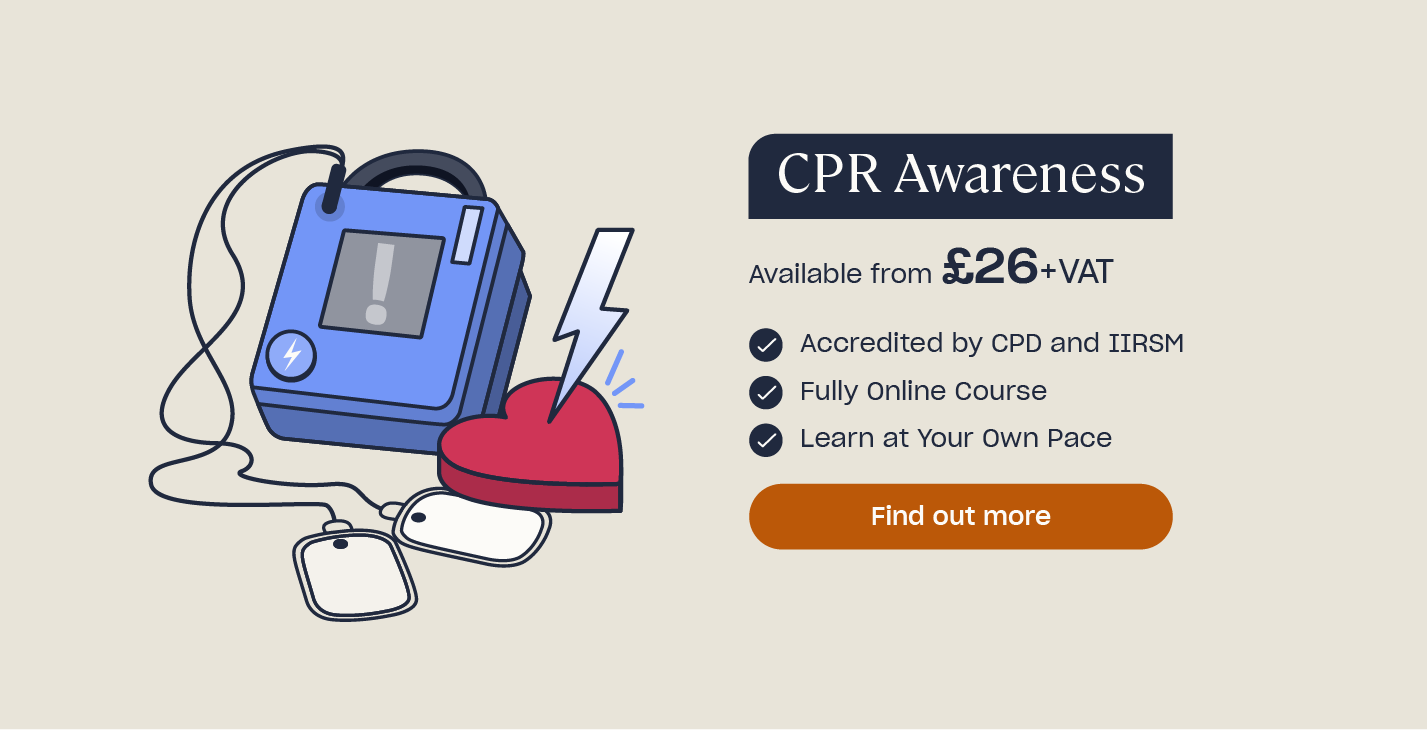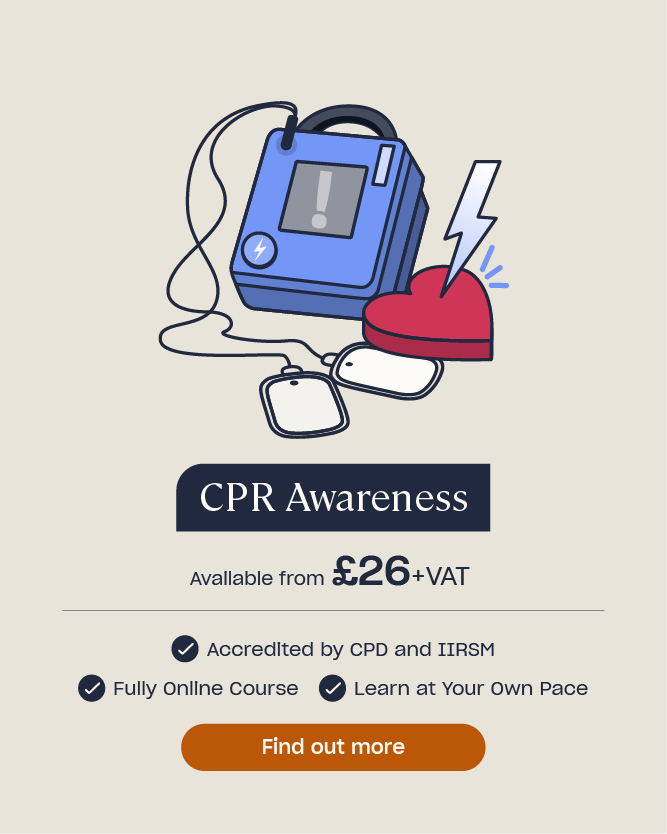How to Carry Out the Primary Survey Using the DRABC Steps
Having the knowledge of how to react in a medical emergency and give first aid is an important skill that everyone should feel confident in. You never know when you might need to put these skills to use and assist someone in a potentially life-threatening situation.
In this article, we explain how you should carry out an initial assessment of someone who is injured or ill. This is known as the primary survey and each of the five steps can be remembered using the acronym ‘DRABC’. We also outline what action you should take after you have completed these steps.
What is the Primary Survey in First Aid?
The primary survey is the first stage in any first aid assessment. It is an initial assessment of the situation and the needs of the casualty that will help you to understand whether you can approach and start to attend to them without putting yourself or anyone else at risk of harm.
It is intended to help you to quickly identify whether there is an immediate threat to the casualty’s life. Applying the primary survey will allow you to determine whether someone has any injuries or illnesses that could be life-threatening and so need to be responded to immediately.
The action you subsequently take may well save their life, so it is important that you understand how to carry out the steps in the correct order. This allows you to consider serious health complications in order of priority, firstly assessing those that will cause fatality the quickest.

When Should the Primary Survey be Used?
You should use the primary survey whenever you discover a casualty – someone who is injured or has fallen ill. This may be due to an identifiable accident or incident, such as a fall, or the cause may initially be unapparent, such as due to an individual’s long-term medical condition, like diabetes.
Anyone can use the primary survey to assess a casualty. However, if a qualified first aider is present, they will likely carry out this initial assessment and then administer any treatment to the casualty. Note that qualified first aiders must have taken practical training of at least 18 contact hours.
If a qualified first aider cannot attend, then some workplaces may have an appointed person present. Appointed persons are in charge of first aid arrangements at workplaces. Depending on the individual’s role and competence, the appointed person may also be able to provide emergency cover, including carrying out the primary survey, if a first aider is absent due to unforeseen circumstances.
If someone requires first aid assistance outside of a workplace, such as in your home, you can carry out the primary survey yourself if you feel competent in doing so. This action may save the casualty’s life and so it is crucial that you understand how to carry out the primary survey and address any life-threatening issues before emergency medical help arrives.
Need a Course?
Our CPR Awareness training course is suitable for anyone who wants an understanding of how to carry out CPR, as well as those who want to refresh their existing knowledge. It is designed to help ensure as many people as possible have an awareness level of how to recognise when someone needs CPR and how to administer it.
How Do I Use the DRABC Steps?
To carry out the primary survey, you should follow five steps, which can be remembered by the acronym ‘DRABC’. These must be followed as they are, in order of priority, to ensure the most life-threatening conditions are assessed and treated first.
The five steps are:
- Danger
- Response
- Airway
- Breathing
- Circulation.
Step 1 – Danger
The first step in the primary survey is to assess the situation for any danger. It is crucial that this is the first thing that you do so as to ensure that it is safe for you to approach the casualty. This means you need to look around the area for anything that could be a potential risk to you, the casualty, or anyone else nearby.
Signs of danger may include:
- Moving vehicles.
- Broken glass.
- A live electrical current.
- Fire and/or smoke.
If you identify any of these or other potential dangers, you must try to make the area safe before you approach the casualty. For example, if there is a live electrical current, you may be able to switch off the power at the source. If this isn’t possible, you may be able to disconnect the current to the casualty by moving them with something that doesn’t conduct electricity, such as wood or plastic. You must not touch the casualty directly.
Once you have made the area safe, or if there are no dangers to begin with, you can safely approach the casualty. If you are unable to make the area safe, you should not approach the casualty and instead should call for emergency medical assistance.

Step 2 – Response
Once you have ensured that it is safe to approach the casualty, you should check whether they are responsive. You should do this by asking them verbally whether they’re ok, to look at you, or to raise their hand.
If the casualty responds to you, either by speaking or moving, then you should attend to any injuries or illnesses that they have before moving on to the next step.
If the casualty doesn’t respond, you should try tapping them on their arm or gently shaking their shoulder. You must not shake them firmly because this could worsen any potential neck or back injuries.
If there is still no response from the casualty, you should move on to the next step of the primary survey and call the emergency services for help if they haven’t already been called.
Step 3 – Airway
The third step of the primary survey is to check that the casualty’s airway is open and clear from obstructions.
If the casualty is unresponsive, you should:
- Put your hand on their forehead and gently tilt their head back, lifting the chin. Do a visual check of their airway for any obstructions.
- Carefully remove any visible obstructions. Do not put your fingers in their mouth if you can’t see anything, as this risks pushing a potential blockage further down.
- Move on to the next stage of the primary survey immediately.
If the casualty is responsive, you should:
- Check if anything is blocking their airway that could cause them to choke.
- You should encourage them to remove an obvious blockage themselves, with their hands or by coughing.
- If they are unable to dislodge the blockage themselves and are severely choking, you need to help them to remove it. To do so, you must not put your fingers into their mouth. Instead, you should give choking adults and children a combination of back slaps and abdominal thrusts, and a combination of back blows and chest thrust to infants under one year old.
- Move on to the next stage of the primary survey once the blockage is clear.

Step 4 – Breathing
Next, you must check whether the casualty is breathing normally. To check their breathing, you should look, listen and feel for it by tilting their head back, looking for chest movement and listening for breathing sounds. Feel for air from their mouth or nose on your cheek for 10 seconds. It’s essential to check for breathing for 10 seconds to confirm that the breathing is rhythmic and normal.
If the casualty is breathing normally, move on to the final step of the primary survey.
If the casualty is unresponsive and not breathing normally, you must ensure that the emergency services have been called. If you have had practical first aid training and are confident, start to give CPR with rescue breaths. If you haven’t had practical training, you should give hands-only CPR, without rescue breaths. If available, you should ask someone else to find and bring a defibrillator (AED) to use.
Step 5 – Circulation
You should only move on to the final step of the primary survey if the casualty starts to breathe independently. For this step, you need to check the casualty for any signs of severe bleeding.
If the casualty is bleeding heavily, you need to control and reduce the bleeding. Apply direct pressure to the wound with a sterile dressing, if possible, or a clean cloth. You should also ensure that the emergency services have been called if they haven’t already.
If they aren’t bleeding severely and you have been able to work through the previous stages of the primary assessment, you should try and reassure them that help is coming. Stay with them until medical help arrives.
If the casualty isn’t bleeding, but is unresponsive and breathing normally, you must put them into the recovery position. This will keep their airway open, preventing them from choking if they vomit. The emergency services should be called if they haven’t already been.

We have created a poster that shows the steps of the primary survey through the acronym ‘DRABC’. You may wish to print this out and display it in your workplace as a handy reminder of what to do if someone needs first aid assistance. The DRABC steps poster can be downloaded at the link below.
What Should I Do After the DRABC Steps?
After you have completed the primary survey using the DRABC steps, you should carry out what is known as the secondary survey. At this stage, you are trying to find out more about what has happened to the casualty. You should do this through observations, talking with the casualty and physical examinations of their body.
Observations and Communicating with the Casualty
Part of the secondary survey requires you to gather information about the casualty and incident through observation and by talking with them. You need to find out:
- What has happened? If the casualty is conscious, ask them to explain what happened and how. Ask the same of any witnesses.
- What symptoms do they have? Ask the casualty short and simple questions about any sensations or symptoms they are experiencing. Try and identify where they are feeling any pain and how severe it is, such as on a scale of one to ten.
- What can you see? Check their body for any secondary illnesses, such as discolouration. Compare the injured side of their body with their uninjured side for any differences.
When talking with the casualty, try to get as much information about their medical history and current symptoms as possible. Knowing this will help you to identify what might be wrong and how to treat them. You can use the ‘AMPLE’ acronym and ask the casualty about:
- A: Any allergies they have.
- M: Any medication they take regularly or have been prescribed.
- P: Their previous medical history.
- L: When they last ate something.
- E: What happened leading up to the event that caused their injury or illness.

Physical Examination
Having observed the casualty and spoken with them, you should then move on to a physical examination. Consider:
- What can you feel? Carefully feel over their body to determine whether anything feels abnormal, such as swelling or broken bones. Make sure to inform them and ask their permission before doing so.
- What can you smell? Check the casualty’s breath for any distinctive smells. A fruity odour, for example, may be an indication that the person has diabetes.
During the secondary survey, you should examine the casualty from head to toe to check for any injuries or symptoms of potential health issues. This enables you to treat any minor injuries and help to keep the casualty reassured and comfortable before further help arrives.
If the casualty is responsive, talk them through what you’re doing and always ask for permission if you need to loosen or remove any clothing. Remember to treat the person with dignity and respect at all times.
You should also make a note of any minor or serious injuries that you find and then pass this information on to the emergency services when they arrive.
Having the confidence in your ability to carry out the primary survey is an essential part of administering first aid. You must understand the order of priority of the five steps, which can be remembered by the DRABC acronym, and know what action to take in various situations. This knowledge may well help to save someone’s life.
Further Resources:
- Workplace First Aid Training
- What are the Responsibilities of a First Aider?
- Paediatric First Aid Quiz
- How to Support Individuals After Giving First Aid Assistance
- Guidance on What To Do If Someone Is Choking
- CPR Awareness Training







